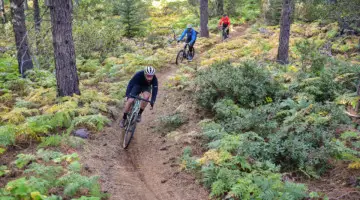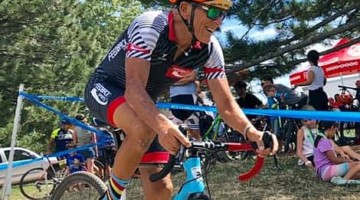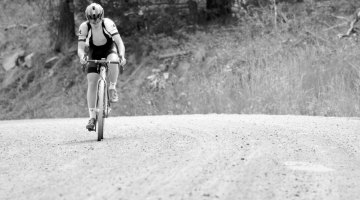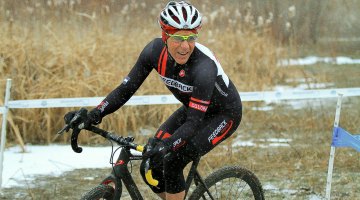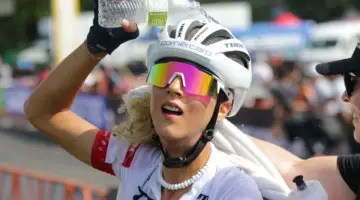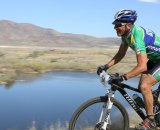
Lee Waldman temporarily trades in his cyclocross bike for a spin on his mountain bike. © Lee Waldman
This week, Masters racer and Cyclocross Magazine columnist Lee Waldman offers some hard-learned lessons after an endurance mountain bike race. If you missed it, be sure to check out Lee’s previous column, Waxing Poetic.
It was just last year when I wrote that short-track mountain bike racing was the key to preparing for the upcoming cross season. Not racing the road, I still wanted to keep that edge that only real racing can give you. So, I turned to the C.U. Cycling Short Track Series. The fit seemed perfect: short, intense races that mimicked the effort and style of cyclocross racing. Because they were short, they allowed for more training on race days. I’ve added something else. Something even more intense and painful in it’s own way. Endurance racing.
On May 7, the weekend after my 61st birthday, I did my first. It was 60 miles on the mountain bike. I can safely say, now that I can think, walk and talk in complete sentences again, that a 45 minute ’cross race will seem almost like a walk in the park. This race covered the 60 miles in a touch less than five hours. Endurance racing takes suffering on the bike to a completely different level. I’ve ridden my road and my mountain bike race for five hours before. What I haven’t done is to race it for five hours.
My first lesson – use chamois butter. Need I say more? The race was hard enough but riding most of the last lap out of the saddle, for obvious reasons, added another dimension of suffering.
Lesson two – don’t ever listen to the other riders describing the course as boring / easy / non-technical. The course, a ten mile loop, included three surprisingly TOUGH climbs, and two moderate ones per lap was none of those despite how it appeared. I have no idea what the total elevation gain for the race was; it was enough. What I do know is that at one point I seriously entertained the idea of walking the last two climbs on the last lap. When I was really hurting about half way through that last, painful lap, the two things that got me to the finish line were: 1) The food at the end, and 2) the negotiations I was doing in my head allowing myself to walk the last short, steep hill to the finish line. In the end though, my pride got in the way and I rode the whole thing.
Lesson three – there’s no such thing as a “training race.” Bottom line; when the whistle blows, we’re racing. Strangely enough the 20-29 age group started their race at the same time as the 50+ and 60+ riders. Now, one would think that those young bucks would be gone before the rest of us even got clipped in; that they would be gone in the first 100 meters and then the rest of us would settle in. Interestingly though the strongest riders in the race were the 50+ riders. They lead it out, led up the first climb and the fastest ones were gone.
Riding in the first group on the first lap, I was stoked to say the least. After all, I’m never sure at the beginning of a race just how my fitness stacks up against the rest of the field. Knowing that I was the second oldest rider in the group simply fueled my resolve to stay near the leaders for as long as was possible. Telling myself that I was just riding “for training” helped to lessen the pressure I regularly put on myself.
Lesson four – no matter what they say, full suspension rocks! For the first time in three years, I’m riding a fully suspended 29er. It’s was a compromise that I reached to save my 61 year-old back for cyclocross. And, it did. First of all I found that I could climb better. No matter what others say, I don’t notice the difference between a full suspension bike and a rigid bike when climbing. It’s nice to know that the wheels stay on the ground providing traction. It’s also less fatiguing for me at least, to not have to fight the bike all the way up and then all the way down.
Lesson four ‘A’ – the bike does make a difference. Where the bike shone was on the corners and descents. Simply put, it rocked. I was flying down rocky drops and rail corners like nothing I’d ever seen before. I remembered riding with a friend a few weeks back still on my hardtail. At the bottom of one bouncy descent I finally caught up to him and asked him his secret to descending smoothly. He was, by the way, on a full suspension 29er. His answer seemed so simple at the time, yet impossible. “Soft hands,” he said. Easy, don’t use a death grip on the bars. The problem was that I couldn’t understand how to do that and still keep the bike under me. Riding the full suspension bike, it all started to make sense. It’s easy to be light on the bars when not fighting for control.
In the past I’d try to distance weaker climbers so that when they flew by me on the downhills we would end up in the same place at the bottom. Eventually my theory was that I’d put enough ground between us on the climbs that they would give up and let me go.
But with the new bike, not only was I glued to them on the downhills, I was also right there going through the corners. And, the further into the race we got, the more confident I became in myself and the bike. I learned that my misunderstood struggles in the past with my cornering wasn’t so much my technique as it was my equipment.
Never being one to blame my equipment for my shortcomings, it’s hard to admit, but the bike did make a world of difference. My confidence, always my Achilles heel, no longer held me back. I may not have been passing riders on the descents, but they weren’t dropping me either.
Last lesson – 60 miles is 60 miles and I was fried at the end. But, I made it. Not only that, but I’m already marking off the days till the next one in mid-June. I came away lighter by about 3000 calories, fitter, and a whole lot more confident.
One quick side-note: at the end of the race I was trying to get back to my team tent. There was a small fence in the way, only about two feet high. I was so tired I had to sit and beg for help to lift my bike over the barrier. Not only that, I was too tired to shout so I sat there, pathetic, gesturing for our shop owner, hoping he’d notice me and come to my aid. He did, I made it, I’m ready for more.
Go ride.























